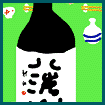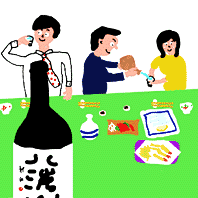|
|
|
|
|
|
|
|
|
|
|
|
|
|
|
|
|
|
|
|
|
|
|
|
|
|
|
|
|
|
|
|
|
|
|
|
|
|
|
|
|
|
|
|
|
|
|
|
|
|
|
|
|
|
|
|
Japanese
began producing SAKE sometime after the introduction of wet rice cultivation
in the 3rd century B.C. The first written record of SAKE being consumed
in Japan dates from about 300 A.D. In ancient Japan, SAKE production was
confined primarily to the Imperial court and to large temples and shrines.
As a result, SAKE has traditionally been associated with religious ceremonies
and festivals.In the 12th century, while the court continued to play a central
role, warriors established a new society.With the development of a stable
cash economy, the court's SAKE breweries became independent. By the end
of the 14th century, several hundred breweries were flourishing. The history
of SAKE coincides with the history of Japanese culture. Today, some 2,000
breweries of all sizes produce more than 10,000 brands of SAKE. SAKE is
loved by both men and women in Japan, and recently, health-conscious young
people are gaining a new appreciation for SAKE. |
|
|
|
|
|
|
|
|
|
|
|
|
|
|
|
|
|
|
|
|
|
|
|
|
|
|
|
|
|
|
|
|
|
|
|
|
|
|
|
|
|
|
|
|
|
|
|
 |
|
|
|
|
|
|
|
|
|
|
|
|
|
|
|
|
|
|
|
|
|
|
|
|
|
|
|
|
|
|
|
|
|
|
|
|
|
|
 |
|
|
|
|
|
|
|
|
|
|
|
|
|
|
|
|
|
|
|
|
|
|
|
|
|
|
|
|
|
|
|
|
|
|
 |
|
|
|
|
|
|
|
|
|
|
|
|
|
|
|
|
|
|
|
|
|
|
|
 |
|
SAKE
is made primarily from rice and water, using KOJI, or SAKE yeast. A special
kind of highly polished rice is used in making SAKE. The fermentation process
for making SAKE is more complex than that for making beer or wine, taking
three to four times longer than fermentation of grapes to make wine. Properly
controlling the complex SAKE brewing process requires special knowledge
and expertise. |
|
|
|
|
|
|
|
|
|
|
|
SAKE
is usually classified into six or seven taste categories. However, there
are hundreds of terms used to describe the taste of SAKE, and more still
to describe the bouquet, yielding a seemingly limitless vocabulary for the
subject. Here, we will note just two terms commonly used among Japanese
in classifying the taste of SAKE: KARAKUCHI and AMAKUCHI. KARAKUCHI means
dry and smooth, whereas AMAKUCHI refers to a slightly sweet taste. Between
dry and sweet there are several further distinctions. It's up to you to
determine your favorite balance of taste and bouquet. |
|
|
|
|
|
|
|
|
|
|
|
|
|
|
|
|
|
|
|
|
|
|
|
|
|
|
|
|
|
|
|
|
|
|
 |
|
|
|
|
|
|
|
|
|
|
|
|
|
|
 |
|
|
|
As
we mentioned, a great number of terms are used to classify the taste of
a SAKE. Sometimes, two different terms are used to describe a single type
of SAKE. Generally, though, the words NIHON-SHU, meaning Japanese SAKE,
and SEI-SHU, meaning refined SAKE, distinguish SAKE from other alcoholic
drinks. |
|
|
|
|
|
|
|
|
|
|
|
|
|
 |
|
|
|
|
|
|
|
|
|
|
|
|
|
|
|
|
|
 |
|
|
|
|
|
|
|
|
|
|
|
|
|
|
|
|
|
|
|
|
 |
|
|
|
|
|
|
|
|
|
|
|
|
|
|
|
|
|
|
|
|
|
|
|
 |
|
|
|
|
|
|
|
|
|
|
|
|
|
|
|
|
|
|
|
|
|
|
|
|
|
|
|
|
|
|
|
|
|
|
|
|
|
|
|
 |
|
|
Let's
examine the terms JUNMAI-SHU and GINJO-SHU. JUNMAI means "pure rice." GINJO-SHU
is a special type of JUNMAI-SHU regarded as the ultimate achievement in
SAKE brewing. In producing GINJO-SHU, the rice is polished until no more
than 60% of the original grain remains. The GINJO-SHU method produces a
fruity aroma unlike any other drink. GINJO-SHU production makes nerve-wracking
demands on the brewer, who must work with great care and precision, performing
most tasks by hand. Until 20 or 30 years ago, GINJO-SHU was brewed only
in small quantities, making it a rare delicacy for average consumers. Now,
however, it is possible to find it at large SAKE shops, and it is produced
in all regions of the country. |
|
|
|
|
|
|
|
|
|
|
|
|
|
|
|
|
|
|
|
|
|
|
|
|
|
|
|
|
|
|
|
|
|
|
|
|
|
|
|
|
 |
|
|
|
|
|
|
|
|
|
|
|
|
|
|
|
|
|
|
|
|
|
|
|
|
|
|
|
|
|
|
|
|
|
|
|
|
|
|
|
|
|
|
|
|
|
|
|
|
|
|
|
|
|
 |
|
|
|
|
|
|
|
|
|
|
|
|
|
|
|
|
|
|
Discover
delicate and subtle tastes as you explore the world of SAKE. There is no
textbook to guide you. The adventure awaits. |
|
|
|
|
|
|
|
|
|
|
|
|
|
|
|
|
|
|
|
|
|
|
|
|
|
|
|
|
|
|
|
|
|
|
|
|
|
|
|
|
|
|
|
|
|
|
 |
|
|
|
|
|
|
|
|
|
|
|
|
|
|
|
|
|
|
|
|
|
|
|
|
|
|
|
|
|
|
|
|
|
|
|
|
|
|
|
|
|
|
|
|
 |
|
|
|
|
|
|
|
|
|
|
|
|
|
|
|
|
|
|
|
|
|
 |
|
|
|
|
|
|
|
|
|
|
|
|
|
|
|
|
|
|
|
|
|
|
|
|
|
|
|
|
|
|
|
|
|
|
|
|
|
|
|
|
|
|
|
|
|
|
|
|
|
|
|
|
|
|
|
|
|
|
|
|
|
|
|
|
|
|
|
 |
|
|
|
|
|
|
|
|
|
|
|
|
|
|
|
|
|
|
|
|
|
|
|
|
|
|
|
|
|
|
|
|
|
|
|
|
|
|
|
 |
|
|
|
|
|
|
|
|
|
|
|
|
|
|
|
|
|
|
|
|
|
|
|
|
|
|
|
|
|
|
|
|
|
|
|
|
|
|
|
|
 |
|
|
|
|
|
|
|
|
|
|
|
|
|
|
|
|
|
|
|
|
|
|
|
|
|
|
|
|
|
|
|
|
|
|
|
|
|
|
|
|
|
|
|
 |
|
|
|
|
|
|
|
|
|
|
|
|
|
|
|
|
|
|
|
|
|
|
|
|
|
|
|
|
|
|
|
|
|
|
|
|
|
|
|
|
|
|
|
|
 |
|
|
|
|
|
|
|
|
|
|
|
|
|
|
|
|
|
|
|
|
|
|
|
|
|
|
|
|
e-mail
hakkai@sakebar.net
(C)Copyright 1999 HAKKAISAN BREWERY CO.,LTD. All right reserved.
|
|
|
 |
 |
 |
 |
 |
 |
 |
 |
 |
 |
 |
 |
 |
 |
 |
 |
 |
 |
 |
 |
 |
 |
 |
 |
 |
 |
 |
 |
 |
 |
 |
 |
 |
 |
 |
 |
 |
 |
 |
 |
 |
 |
 |
 |
 |
 |
 |
 |
 |
 |
 |










